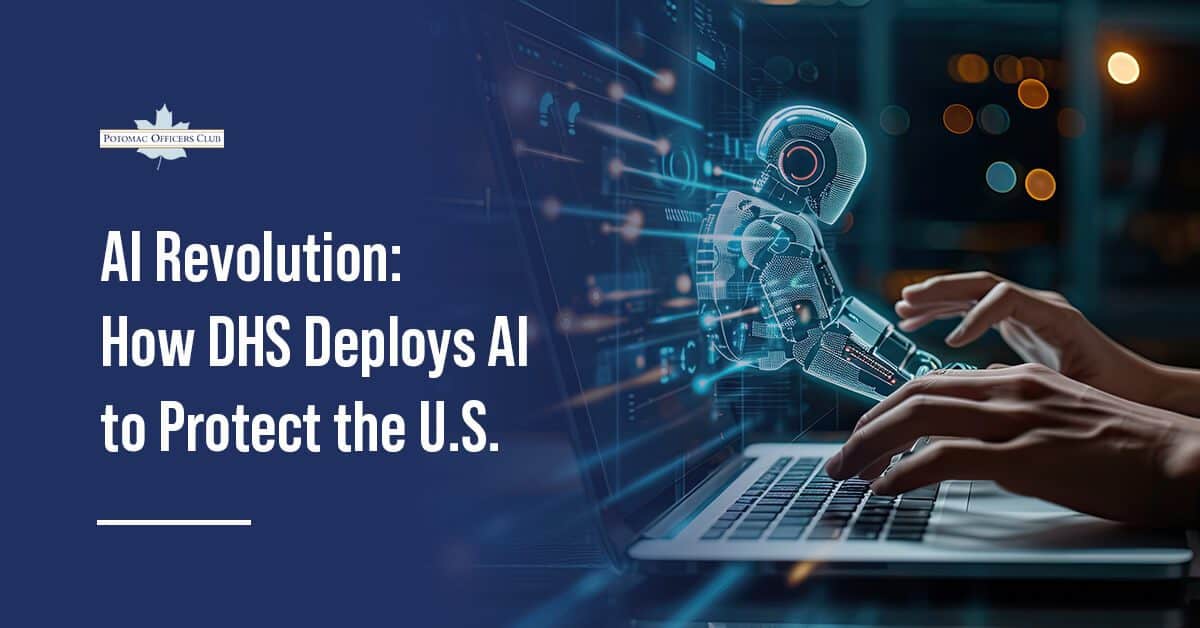
AI Revolution: How DHS Deploys AI to Protect the US
AI promises to transform homeland security in the U.S. by improving the accuracy, speed and ease of many of the Department of Homeland Security’s key missions. It has the potential to advance automation, enhance data analysis and bolster the nation’s resilience against cyber threats, among other uses.
Potomac Officers Club sat down with a pair of subject matter experts who are speaking at the upcoming, heavily AI-focused 2025 Homeland Security Summit to get the details on the rewards, and hurdles, involved with using AI in homeland security missions. One big challenge is integration—ensuring this modern technology doesn’t rupture legacy systems.
April Fordyce, Slalom’s senior director and DHS account lead, told POC in an exclusive interview that balancing innovation and stability is absolutely critical for maintaining operations and delivering on the mission.
“One of the most pressing challenges in homeland security today isn’t just adopting new technologies—it’s modernizing legacy systems while maintaining operational continuity,” Fordyce said. “As we integrate AI and automation into security infrastructure, we must ensure these solutions can work seamlessly with existing systems while providing the flexibility to adapt to future threats.”
Learn more about federal AI integration in homeland security at the Potomac Officers Club’s 2025 Homeland Security Summit on Nov. 12! Fordyce will moderate the “From Lab to Launch: Advanced AI Applications in National Security” panel discussion about the latest ways AI is improving U.S. homeland security. Joining Fordyce for this critical conversation will be CISA Chief Information Officer Robert Costello. Sign up today for this elite GovCon event specifically designed for GovCon technology professionals!
How Is AI Used in National Security?
DHS is already using AI to enhance U.S. national security. One way is by leveraging advanced machine learning models to assess the risk of drivers entering the nation at land border crossings.
Customs and Border Protection officers performing interviews at land points of entry have less information in advance about who they’re interviewing compared to customs officials at airports, who get dossiers usually hours in advance. CBP officers recently used AI to further investigate a motorist suspected of bringing drugs into the U.S.
CBP officers used AI in a process that took 1.4 seconds to identify a possibly suspicious pattern in a motorist’s border crossing history. The AI application then flagged the driver for an alert for greater inspection by CBP officers. Following the alert, the CBP officials referred the vehicle for a secondary inspection, where other officers discovered over 165 pounds of narcotics hidden in the vehicle’s rear quarter panels and gas tank, Eric Hysen, former DHS chief information officer and chief AI officer, told a House panel in 2023.
How Is AI Used in Criminal Investigations?
DHS has also used AI to strengthen its investigative work in prosecuting child sexual abusers. Hysen said Homeland Security Investigations used AI and machine learning to enhance older images, which provided investigators with new leads and turned previously cold cases into rescues and arrests.
Homeland security professionals have leveraged AI to better analyze unwieldy amounts of data. Hysen said DHS investigators used AI to analyze otherwise burdensome amounts of data resulting from court-ordered mobile device extractions. This allowed them to identify trends and isolate criminal patterns to support Immigration and Customs Enforcement missions and enforce the law.
AI tools will significantly decrease the time that agents and officers spend on manual data entry and analysis, allowing them to focus on other investigative activities and make better informed, data-driven decisions. — Eric Hysen, former DHS chief information officer and chief AI officer
What’s a Unique Use for AI in Homeland Security?
While AI has great potential for improving how homeland security professionals analyze data, it needs to ensure the data can be used appropriately across divisions. Phil Miller, Procentrix senior vice president for law enforcement and judiciary programs, told POC that sharing this critical information in a way that is secure, searchable and scalable is vital to the success of the homeland security enterprise.
“Using this information to develop a more holistic understanding of the threat environment that augments the work of homeland security professionals is proving to enhance decision making and operational effectiveness,” Miller said. “Industry’s ability to identify emerging technologies and educate the government on the value of adopting emerging technologies will be key to growing the DHS-industry partnership to secure the homeland.”
Hear Miller moderate a panel about the hottest issues in AI and homeland security at the Potomac Officers Club’s 2025 Homeland Security Summit on Nov. 12! Get actionable business intelligence at the “Mission Ready: AI and COTS Powering DHS Innovation” panel discussion. Better tailor your offerings for DHS solicitations in FY 2026. Secure your seat today!

Category: Articles





